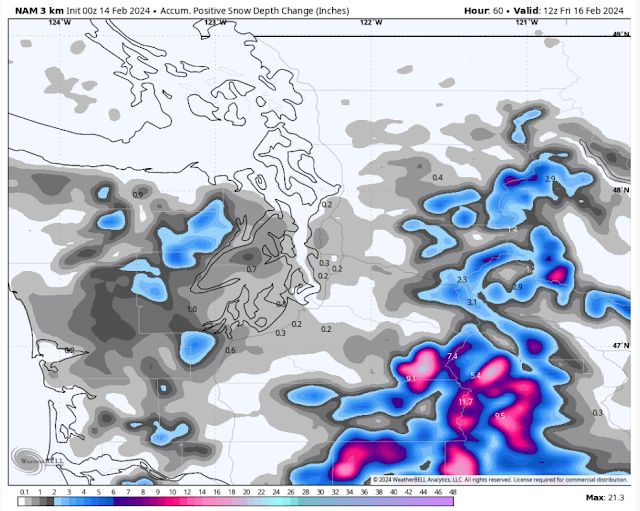FastCast--Friday, Mar. 1 to Monday, Mar. 4:
Persistent showers will continue to impact the Pacific Northwest as we begin March. With colder than normal air in place, most moderate to heavy showers have the potential to bring rain/snow mix or light snow accumulations. This is even more likely near Hood Canal and on the Kitsap Peninsula, on the region's higher hills (generally 500+ feet), and from Olympia southward. Generally, expect highs through Monday to only reach the low to mid 40s, with lows in the low to mid 30s. From Thursday night to Friday, areas from Olympia south and most areas west of Puget Sound have a potential to see brief accumulating snow. Disregarding snow, expect it to be on the wet side, with most of Western Washington receiving 0.4-0.8" of rain through Monday, with even more on the coast. The passes will likely see an additional 12-18" of snow through Monday. Stay tuned for another update Friday night as a somewhat uncertain forecast is ahead.
--------------------------------------------------------------------
Continue reading the full blog below!
A chilly and showery few days is ahead for Western Washington, and most showers have the potential of producing rain/snow mix, or brief snow in localized parts of the region. Let's take a look at the forecast!
We'll start with what I think is the most likely forecast, the NWS NBM model. This forecast is for total snow through Friday afternoon.
This forecast shows a trace to 0.5" of snow from Olympia southward, with 1-2" possible on the Kitsap Peninsula, and up to 3" around Hood Canal. Parts of the Northern WA Coast could get up to 1-2".
Next, the NAM high-resolution forecast for snow through Friday afternoon.
This forecast highlights some areas for potential snow, mainly areas west of Puget Sound and in the North Sound. One thing to note is that much of this forecasted accumulation won't happen, but this is good for seeing where a higher probability of accumulating snow exists. Be aware if you're along Hood Canal and in the hills along the WA coast.
Let's compare this to the HRRR high-resolution forecast, also showing snow through Friday afternoon.
This forecast shows the highest probability for snow is from Olympia west and south, and along the Kitsap Peninsula and Hood Canal, with a slight chance of snow for the I-5 corridor north of Olympia.
Let's take a look at temperatures. Below is the forecast for Friday morning's lows from the NAM high-resolution model.
This shows why it'll be quite hard for any real snow to accumulate in Western Washington. Lows will only reach the 32-35° range, meaning that snow has very little chance of actually sticking to anything. In Eastern Washington, expect lows in the upper 20s to low 30s, except in the mid to upper 30s for most of the Columbia Basin.
Since there is a relatively low potential for actual accumulating snow in Western Washington, most showers will be producing rain. Here's the NAM high-resolution forecast for total rain through Friday afternoon.
Expect 0.1-0.3" for most of the I-5 corridor, with the Kitsap Peninsula getting 0.3-0.6", and the coast getting 0.5-1.5", most under heavy showers.
Stay tuned for an update on Friday night, as a small low pressure system is moving into the Northwest. The forecast for this is still uncertain, so stay tuned for updates!


















































